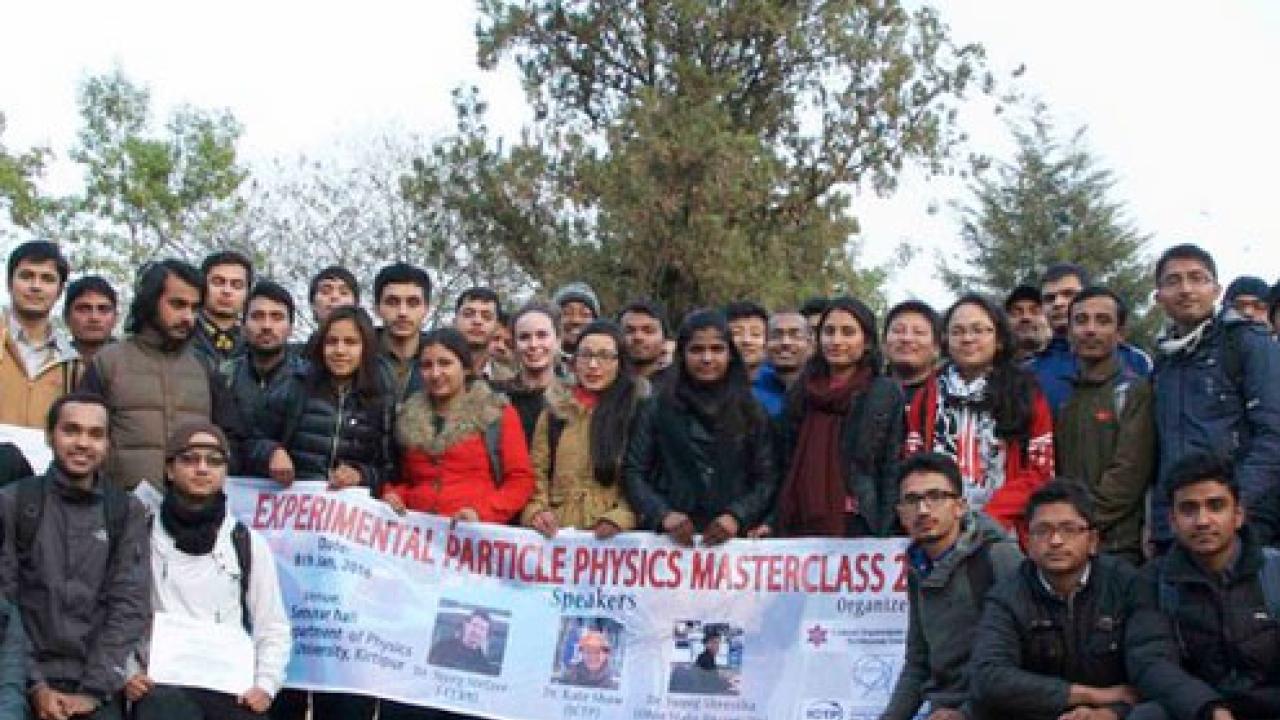
Without a particle accelerator, or even a reliable computer, it can be difficult to get excited about high energy physics, let alone know what higher education opportunities exist. These are some of the challenges ICTP's Physics Without Frontiers outreach program hopes to combat, as it reaches out to engage young physicists in countries where there are few or no established high energy physicists. In the four years since its inception, ICTP's Physics Without Frontiers outreach program has gone on the road to reach students in Algeria, Palestine, Lebanon, and Vietnam, and has recently returned from a second visit to Kathmandu, Nepal.
"Basically, it's intensive training in particle physics," says Kate Shaw, one of the main organizers and a physicist at ICTP who works on CERN's ATLAS experiment. As usual with Physics Without Frontiers programs, the main focus of the Nepal visit was a day-long masterclass. An intensive set of lectures in the morning preceded the hands-on workshop that took place in the afternoon, where students used recent data from ATLAS. Particle physics involves a lot of detective work, Shaw says, such as figuring out what large particles are decaying into the small particles that the detectors report. At this masterclass, students did some of the detective work themselves and got a taste for puzzling through physics mysteries.
For the first time on a Physics Without Frontiers trip, though, particle physics was not the only masterclass offered. Elisa Fratini, an ICTP postdoctoral fellow, gave a similarly intense workshop in condensed matter physics, for students interested in subfields that don't involve smashing particles. Helping host this workshop was Narayan Adhikari, an alumni of ICTP's Postgraduate Diploma Programme from 1998 and now a professor at Tribhuvan University, one of two institutes of higher education in Kathmandu. All of the trip's activities alternated between Tribhuvan and Kathmandu University, and all the workshops were open to master's level students from both, with no shortage of interested students.
The science itself was not the only focus of the masterclasses. "At the end of the day we promoted everything," Shaw says, such as opportunities for summer schools at CERN, ICTP conferences and the ICTP Diploma Programme. As well as this overview of opportunities in physics higher education, the presenters gave a crash course in basic career advice, including cover letter writing and how to apply for jobs or programs. Having these skills, Shaw says, "can make the difference between getting accepted or not."
Two of the strongest students at last year's Physics Without Frontiers masterclass were successful in their pursuit of educational opportunities in 2015: Yadav Kandel was accepted into the ICTP Complex Systems School, and Santosh Parajuli to the CERN Summer School. "Basically we go around grooming particle physicists," Shaw laughs.
The other two components of Physics Without Frontiers are outreach to policy makers and outreach aimed at the public. Shaw and Fratini, along with the other organizers and presenters--Joerg Stelzer, a CERN physicist, and Suyog Shrestha, a Nepalese postdoc at Ohio State University who also works on the ATLAS experiment--took a five-hour bus ride to the town of Sindhuli to talk to a packed hall of secondary students. "The students asked amazing questions," Shaw says. "We always make a point of bringing that up to policy makers, that these students ask clever, great questions, so we should be supplying them with routes to continue with physics."
The rest of the whirlwind trip saw the Physics Without Frontiers team visiting a secondary science school in Kathmandu, the Nepal Academy of Science and Technology, and the Engineering Department of Tribhuvan University, the latter in preparation for a transfer of 150 computers from CERN. "At the moment they have a corner with about five, so this can really change the way that they are doing science," says Shaw. Other challenges for Nepalese scientists include limited electricity, restricted fuel supplies for generators, and unreliable internet access.
Despite the challenges, all the activities happened thanks to the motivation and organization of a group of young physics students who formed their own outreach initiative, the Milky Way group. The group, which includes the two students who studied at ICTP and CERN, organized many outreach activities up until April 2015, when the earthquake hit. The group served as the local organizers for this Physics Without Frontiers trip, and Shaw hopes to help them restart their outreach efforts with resources and materials. "We've got great hopes that they're going to do great things."
Going forward, that's not the only way the collaboration will continue. Fratini is planning on returning to Kathmandu in March 2016 to teach an intense, one-month course on condensed matter physics, to help fill a need for more lecturers on this topic. She'll also bring a goody bag of physics education materials for the Milky Way group. With luck, this will further the aim of this Physics Without Frontiers trip. "We're trying to make a buzz, get people talking about physics," Shaw says. "We want to get people thinking about the importance of investing in fundamental science."
--Kelsey Calhoun
















